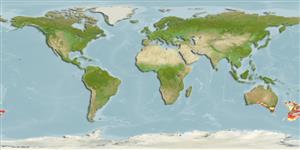Common names from other countries
sub class Elasmobranchii (ฉลามและกระเบน) (sharks and rays) >
Squaliformes (Sleeper and dogfish sharks) >
Oxynotidae (Rough sharks)
Etymology: Oxynotus: oxys (Gr.), sharp; notos (Gr.), back, referring to its keeled back (“dorso carenato”). (See ETYFish); bruniensis: -ensis, Latin suffix denoting place: the shore of Bruny Island, Tasmania, where holotype was discovered in a “dried … but fair state of preservation”. (See ETYFish).
More on author: Ogilby.
Environment: milieu / climate zone / depth range / distribution range
นิเวศวิทยา
เกี่ยวกับทะเล,น้ำเค็ม สัตว์หน้าดินในเขตน้ำลึก; ระดับความลึก 45 - 1070 m (Ref. 26346), usually 350 - 650 m (Ref. 6871). Deep-water; 31°S - 55°S, 125°E - 172°W (Ref. 54691)
Southwest Pacific: confined to temperate waters off southern Australia and New Zealand.
Length at first maturity / ขนาด / น้ำหนัก / Age
Maturity: Lm ?, range 60 - ? cm
Max length : 65.0 cm TL เพศผู้/กระเทย; (Ref. 122636); 74.0 cm TL (female); น้ำหนักสูงสุดที่มีการรายงาน: 6.6 kg (Ref. 122636)
เงี่ยงครีบก้น 0; ก้านครีบอ่อนที่ก้น: 0. Uniform grey-brown coloration; short, blunt snout; high sail-like dorsal fins with spines and broad apices, first dorsal spine inclined backward; high, thick triangular body with large, rough denticles; circular spiracles; lanceolate upper teeth, lower blade-like teeth in less than 12 rows (Ref. 247).
Found on outer continental and insular shelves and uppermost slopes (Ref. 247). Probably feeds on bottom invertebrates and fishes. Ovoviviparous (Ref. 205). Taken incidentally with bottom trawls but probably not used (Ref. 247).
Ovoviviparous, with 7 young in a litter (Ref. 247). Size at birth about 24 cm (Ref. 6871). Distinct pairing with embrace (Ref. 205).
Compagno, L.J.V., 1984. FAO Species Catalogue. Vol. 4. Sharks of the world. An annotated and illustrated catalogue of shark species known to date. Part 1 - Hexanchiformes to Lamniformes. FAO Fish. Synop. 125(4/1):1-249. Rome, FAO. (Ref. 247)
IUCN Red List Status (Ref. 130435)
CITES (Ref. 128078)
Not Evaluated
Threat to humans
Harmless
Human uses
การประมง: ไม่มีผลประโยชน์
ข้อมูลเพิ่มเติม
อ้างอิงการเพาะเลี้ยงสัตว์น้ำประวัติการเพาะเลี้ยงสัตว์น้ำสายพันธุ์พันธุศาสตร์ElectrophoresesอัตราพันธุกรรมโรคการแปรรูปMass conversion
เครื่องมือ
Special reports
Download XML
แหล่งที่มาจากอินเตอร์เน็ต
Estimates based on models
Preferred temperature (Ref.
115969): 6.2 - 10.4, mean 8 (based on 150 cells).
Phylogenetic diversity index (Ref.
82804): PD
50 = 0.5625 [Uniqueness, from 0.5 = low to 2.0 = high].
Bayesian length-weight: a=0.00372 (0.00160 - 0.00860), b=3.15 (2.94 - 3.36), in cm Total Length, based on LWR estimates for this (Sub)family-body shape (Ref.
93245).
ระดับชั้นอาหาร (Ref.
69278): 4.0 ±0.62 se; based on food items.
ความสามารถในการกลับคืนสู่ปกติ (Ref.
120179): ต่ำมาก, เวลาต่ำสุดที่จะทำให้ประชากรเพิ่มขึ้นเป็น 2 เท่าใช้เวลามากกว่า 14 ปี (Fec=7).
Fishing Vulnerability (Ref.
59153): Moderate to high vulnerability (50 of 100).
